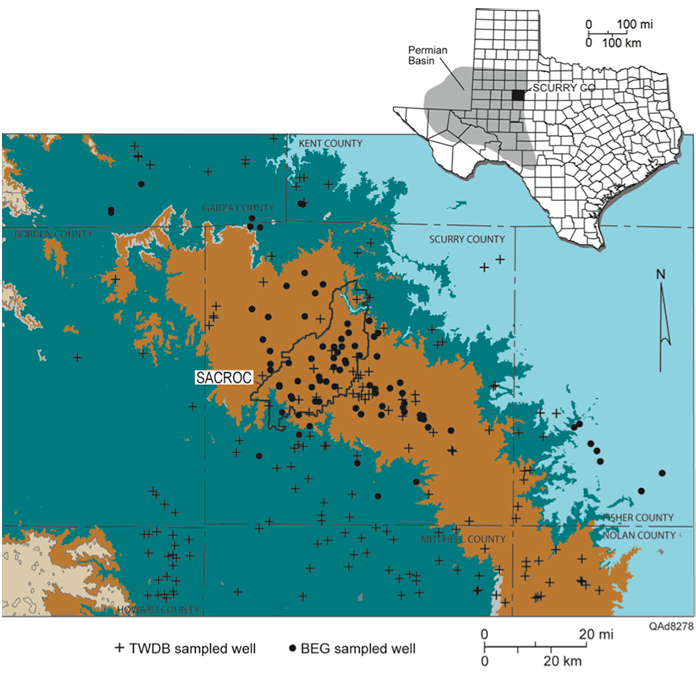SACROC Research Project: Regional Hydrogeology
The SACROC oilfield in Scurry County, near Snyder, Texas, lies on the eastern edge of the Permian Basin in western Texas (Fig. 1). Oil production is from the Pennsylvanian/Permian Cisco and Canyon Reef formations located in the Horseshoe Atoll, one of the largest subsurface reefs in the world at 280 km long and 2000 m depth (Anderson et al., 1954; Olien and Olien, 1982). These late Pennsylvanian/early Permian shelf carbonates are overlain by salt, anhydrite, dolomite, limestone and redbeds deposited in a variety of environments ranging from subtidal to supratidal (Gustavson, 1986). The overlying Triassic Dockum Group, contains the potable water source that is investigated in this study.
Although not used as a major water resource, the Dockum is locally important, serving as the source for local public water supply, irrigation for farming, livestock management, and oil-field operations (Bradley and Kalaswad, 2003). Groundwater in the Dockum Group is fresh to brackish (total dissolved solids < 5,000 mg/L) and is locally impacted by dissolution of evaporite deposits in underlying Permian formations (Bradley and Kalaswad, 2003; Dutton, 1989). This impact is due to interaction between two regional aquifers in the Southern High Plains and Rolling Plains. These aquifers include: 1) the Southern High Plains aquifer (SHP) residing primarily in the Tertiary sediments of the Ogallala formation, but also including the Dockum group down to the evaporite-bearing Permian Quartermaster Formation and Whitehorse Group (Richter and Kreitler, 1986); and, 2) the more regionally extensive underlying Paleozoic "deep basin brine" aquifer (DBB) that is separated from the SHP by the Permian layers which comprise an evaporite aquitard of halite, anhydrite, carbonate and mudstone (Bassett et al., 1981; Jorgensen et al., 1988).

Location of the SACROC oil field in Scurry county, Texas on the eastern edge of the Permian Basin. The oil field lies on a remnant of Ogallala Formation (Eo) surrounded by outcrops of the Dockum Formation (TrD) which houses the aquifer of interest. Undifferentiated Permian formations (P) outcrop to the east. Sample locations are shown.
Flow within both aquifers is predominantly eastward (McNeal, 1965), with discharge points for the DBB east of the Texas Panhandle in north-central Texas and Oklahoma (Jorgensen et al., 1988) and discharge points for the SHP aquifer just east in the Rolling Plains, near the SACROC study area. Potentiometric pressures of the Dockum group aquifer in some areas indicate the potential for downward flow into the upper portion of the evaporite aquitard (Fink, 1963) causing a zone of dissolution referred to as a "salt dissolution zone." Numerical models by Simpkins and Fogg (1982) and Gustavson et al. (1980) show that meteoric groundwater percolating upward into the up-dip Permian halite deposits moves eastward along highly transmissive dolomite and gypsum layers, discharging in topographically low areas. These mixed waters are transported through fractures from the dissolution zone to the surface, interacting with fresh water along the way (Fink, 1963; Jorgensen et al., 1988). Salt springs attributed to dissolution of underlying Permian sequences of gypsum, halite, and dolomite are well-documented north of Scurry County in Garza, Kent, and Stonewall Counties (Stevens, 1974; Richter and Kreitler, 1986; Richter et al., 1990).
Hydrogeological and hydrochemical results from the SACROC groundwater study



